You’ve heard it said before; age is just a number. But is this true for cyclists? What is the average cycling speed by age? Consider this: Professional cyclists often begin their pro careers by getting signed at the early age of 20.
Some say they peak physiologically by age 27 and retire by their mid-thirties.
Then again, the oldest pro cyclist in 2022 is still going strong at the young age of 51, while others retire much younger. There are various skills, abilities, and even speeds at all ages. But how does age affect your cycling speed? And what other factors are involved? Let’s talk about it!
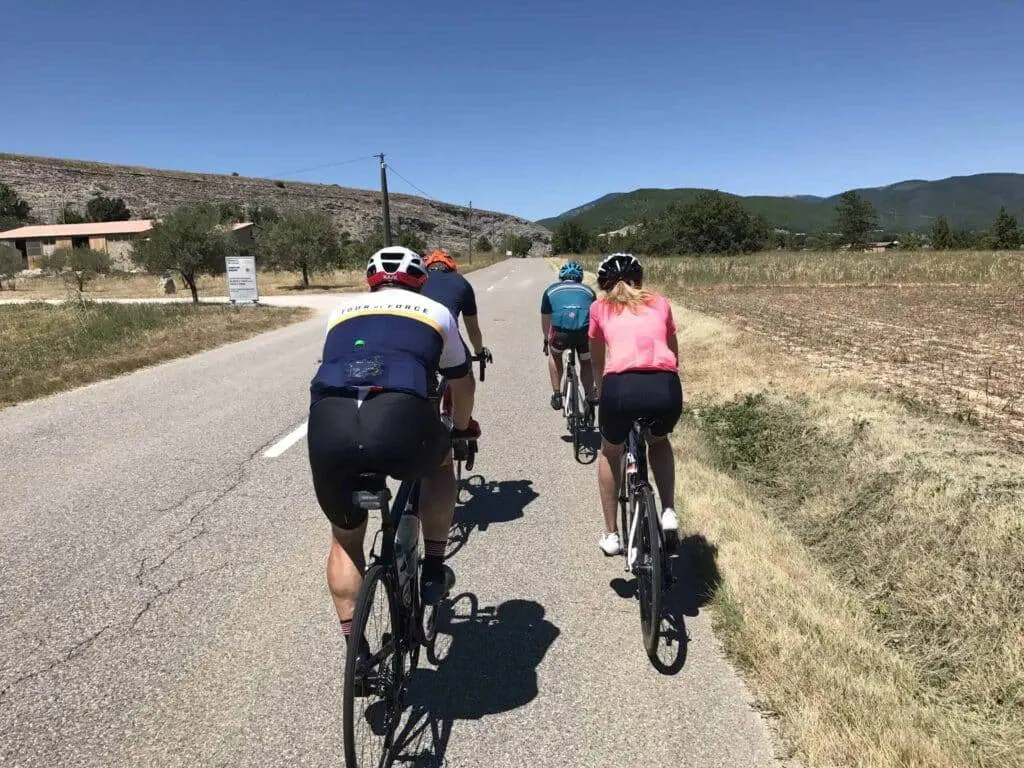
How fast can the average person go on a bike?
Off the couch, a beginner cyclist can usually hit speeds of 8 to 10 miles per hour for about 5 miles. Once they’ve gotten the hang of riding, your typical average cyclist can ride flat roads at around 15 mph for 10 to 20 miles.
As your fitness improves, you may find you can sustain speeds of 18 to 20 mph for up to 30 or 40 miles, especially on flat roads and in a paceline. Elite cyclists usually can hit speeds of 22+ mph, while professional cyclists have no trouble sustaining speeds of 25mph or more on flat roads.
Cycling Speed by Ability
| Rider Level | Average Speed | Sustained Distance |
| Beginner | 8 – 10 mph | 5 miles |
| Intermediate/Average | 15 mph | 10 – 20 miles |
| Advanced | 18-20 mph | 30 – 40 miles |
| Elite | 20-22 mph | 30 – 50 miles |
| Professional | 25+ mph | 30 miles and up |
What is an excellent average speed on a road bike?
A good average speed feels comfortable to you, and you can ride safely. However, for an advanced club rider, you can comfortably say that 18 – 20 mph is a good speed to work towards.
What is a good average speed for a beginner cyclist?
Typical beginner cyclists can usually achieve 8 to 10 mph on flat roads for short trips. If you’re a beginner, you might tire yourself after just a few miles. But don’t get discouraged – you’ll build more tolerance over time!
You’ll also build up bike handling skills, which will help you increase your speed without increasing your level of exertion.
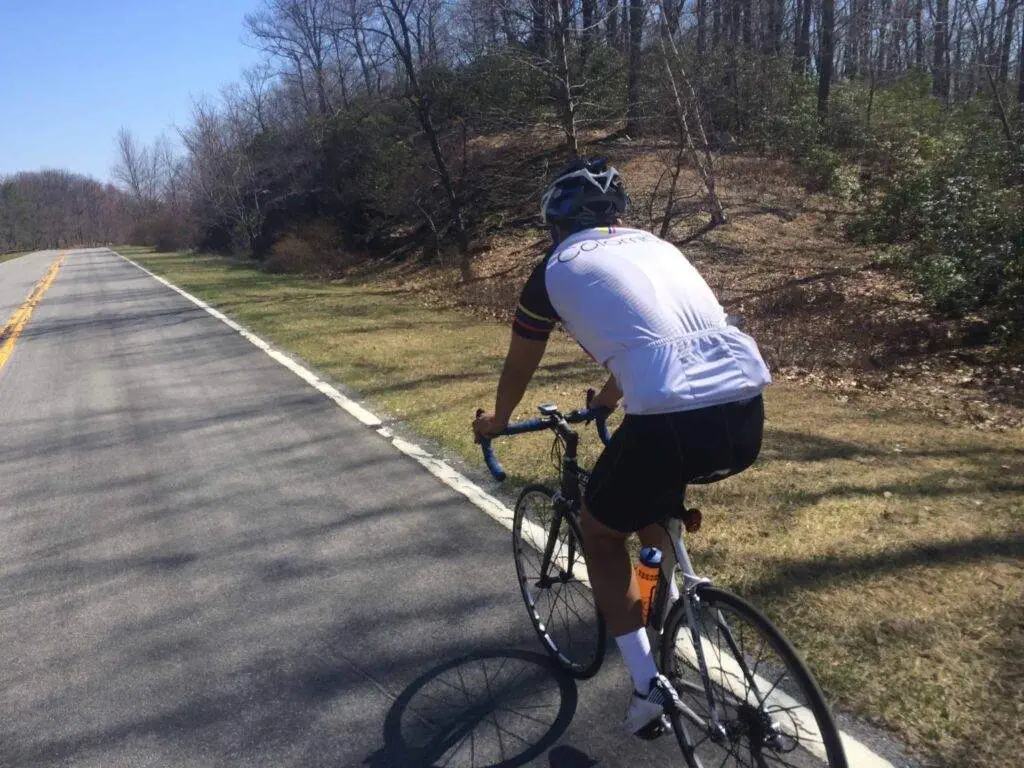
Average Cycling Speed By Age (Key Stats)
In some ways, we don’t know what older athletes can do. In the past, the elderly were told not to exercise a lot because it might cause damage.
However, now we’re learning that exercising even into our higher decades of life can help us live longer and more robustly than we thought was capable.
So how much does speed affect age?
You won’t necessarily get slower just because you are getting older. Several factors affect what happens to us as we age. For example, our max heart rate drops, we lose muscle mass, and we need more recovery time as we age.
However, we also get wiser, ride smarter, and use our skills better, making us faster! According to declinemagazine.com, average speed increases until about the age of 30 to 35 and then begins to decrease again.
Thebikerackdc.com lists average speed by age like this:
- 18–25 years: 17–18.5 mph
- 25–35 years: 20.8–21.7 mph
- 35–40 years: 18.6 mph
- 45–50 years: 15 mph
- 50–55 years: 13.6 mph
On the other hand, declinemagazine.com lists average speed by age this way:
- 18-20 16.7 mph
- 20-25 18.6 mph
- 25-30 21.7 mph
- 30-35 20.8 mph
- 35-40 18.6 mph
- 40-45 17.7 mph
- 45-50 15 mph
- 50-55 13.6 mph
- 55-60 12.4 mph
- 60-65 11.5 mph
Here’s what we can deduce from these charts:
If you’ve been riding consistently but not professionally, you’ll hit your peak speeds around 30. After that, your average speed will drop about one mph every five years. But this information doesn’t consider everything. Many factors can influence when you peak at your average speed and more.
Your Gender Affects Your Average Speed
Typically, biological males have more explosive power and strength than biological females, while females have bodies more suited for endurance work. This is one of the reasons why men and women have separate categories when competing in sports, even in cycling.
So if you compare men to women, you’ll find they have different average speeds. Even with similar levels of training, a man will most likely be 1 to 2 mph faster on average than a woman. But, of course, there are always exceptions, and you may be one of them!
But there are plenty of other factors that also affect your average speed. So let’s take a look at them next.
External Factors That Affect Your Cycling Speed
Cycling speed is affected by so many factors! Your age is just one incidental factor. Let’s look at some others.
Terrain
If you’re riding in a very hilly area, your average speed will be much different than if you ride in a very flat area. For example, your average speed on flats may be around 18-20mph. But you might drop to 8-12 mph when you head to the hills.
Climbing steep inclines can be a humbling experience, even for seasoned cyclists. I recall tackling a hill so formidable that my pace dropped dramatically. In fact, it was so gradual that the autopause feature on my old bike computer assumed I’d stopped and it paused my ride!
That’s when I realized the importance of having reliable gear. I upgraded to the Wahoo ELEMNT BOLT V2 Computer Cycling Bundle, which includes a speed sensor that keeps my ride data accurate, even at snail’s pace up those grueling ascents.
It was a game-changer, ensuring that every inch of elevation gained was meticulously recorded. I highly recommend this bundle for any cyclist looking to track their performance precisely, regardless of the terrain’s challenges
Conversely, if you’re riding downhill, you’ll go much faster, thanks to the forces of gravity. But, if you’re petite like I am, you’ll find heavier people can bomb down those descents faster.
Weather
Weather can help or hurt your average speed. For example, riding with a tailwind, you might be surprised at how fast you can go, even on some minor hills. On the other hand, a heavy headwind will slow you down.
According to roadbikerider.com, a headwind slows you down by around half the wind speed. So if you’re riding at 20mph and have a 20mph headwind, it will slow you down by ten mph to a pace of about ten mph.
Even a wind that isn’t directly straight on can slow you down and tire you out more quickly! So if you ride in a windy city, you might find you have a slower average pace than people who live where there isn’t much wind at all.
Wet weather certainly adds an element of unpredictability to your rides, affecting your average speed. While it’s true that wet roads can sometimes reduce rolling resistance, they also demand extra caution for braking and handling.
After testing various tires to find the optimal balance between speed and safety in such conditions, I’ve settled on the Continental GP5000s as my go-to choice. They are not only tubeless-ready, which is great for reducing flats, but their reliability and durability have been unmatched in my experience.
And for an added touch of style, I always opt for the tan walls – they look sharp and stand out on the road. Trust me, whether you’re riding in the rain or shining under the sun, these tires won’t let you down.
Type of bike
The type of bike you ride has a significant impact on your average speed. TT bikes, with their aerodynamic design, are built for speed on flat, straight courses, while aero bikes offer a fast yet more versatile option.
However, if you’re looking for a bike that embodies both lightness and speed, check out the Trek Emonda. It’s an ultralight, aerodynamic carbon road bike that truly lives up to Trek’s current tagline: ‘Crazy light, crazy fast.’
Not sure if you can see it from the picture of me in action below, but the Trek Emonda is designed for those who want to push their limits on every ride. Whether you’re climbing steep hills or sprinting to the finish, this bike’s exceptional performance is unmistakable.
On the other hand, a heavy hybrid bike or cruiser bike will typically be slower, as they prioritize comfort over the raw speed that you can achieve with a more race-oriented bike.
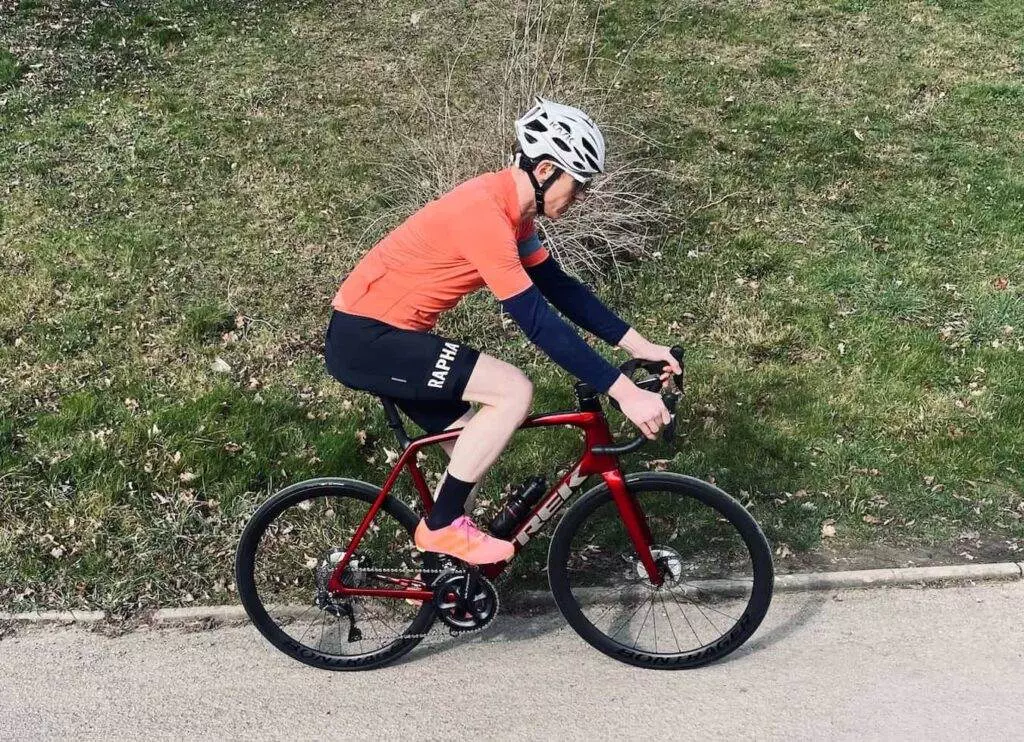
The gears on your bike
The gears on your bike will also have a small effect on speed. If you have easy gears on your bike for climbing, you’ll have an easier time getting up those steep hills. But you’ll run out of hard gears you need for pure speed.
A harder gear will turn the wheels more times per crank of the pedal, but only if you have the strength to turn them over.
Type of tires and air pressure
Wide knobby tires that are designed for comfort and grip will roll more slowly than tiny road race tires on the right terrain. Wider tires with lower air pressure will absorb more of the road lumps and bumps, but they take more effort to power.
On the other hand, if you’re riding on smooth roads, a skinny tire with high pressure will be more efficient and fast. If you’re wondering why you can’t go faster, you might have the wrong tires for the terrain.
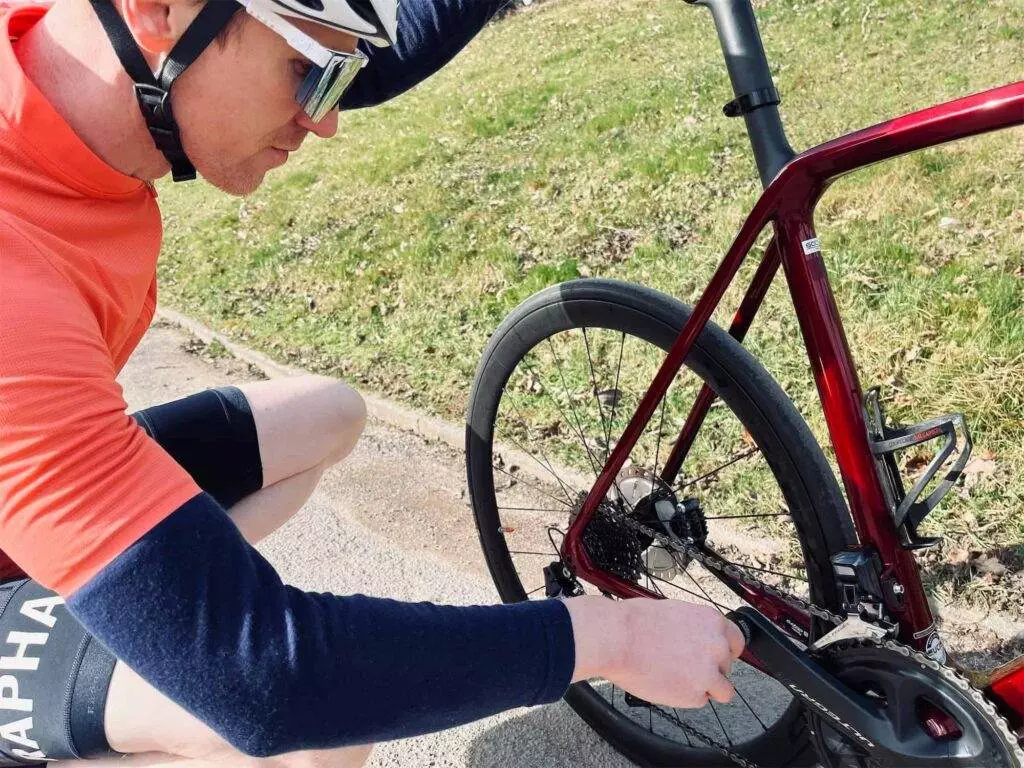
How clean or dirty your bike is
A saying goes, “A clean bike is a fast bike,” and indeed, there’s a kernel of truth to this. Grime in your chain can impede its movement through the drive train, and a bike caked in mud is certainly going to feel more sluggish.
That’s why I always have the Muc-Off Nano Tech Bike Cleaner at the ready in my maintenance kit. Its advanced Nano Technology effortlessly cuts through the toughest of dirt without harming my bike’s finish.
Whether I’m prepping my road bike or gravel bike, it’s my top choice because it’s safe on all components and finishes. Just spray on and rinse off – maintaining a clean, efficient ride has never been easier.
Your clothing
If your clothes are big and baggy, they’ll catch a lot of air, like a parachute. Lightweight, tight apparel, like cycling jerseys, will hug your body and allow the air to flow smoothly overtop.
Your fitness
Your level of fitness determines how fast you can go on your bike. If you’re brand new off the coach, you won’t be as fast as a seasoned professional who has been riding for years. Likewise, if you’ve been ill or haven’t ridden for a while, you may have lost some speed and endurance over time.
But working on your fitness will naturally increase your speed.
The road surface
Road surface also affects your speed. For example, if you’re riding on a smooth cement or wooden track, you’ll go much faster than on a standard asphalt road. On the other hand, gravel or gnarly roads will be slower since you have to plow through gravel, climb over obstacles, and pick a safe line to follow.
Where you are riding
If you’re riding downtown in urban areas, your overall speed will be slower since you’ll need to stop at stop signs, traffic lights, turns, and for pedestrians on the crosswalk. On the other hand, if you ride long rural roads, you might have a faster overall speed.
Who you ride with
If you regularly ride with slower people, your average speed will be slower. If you want to increase your average speed, find some faster mates to challenge your abilities and help you get faster.
How can I calculate my average cycling speed?
The easiest way to calculate your average speed is to use a GPS-enabled bike computer, such as a Garmin, Wahoo, or Karoo. They will calculate your average speed for you in real time.
If you don’t have a bike computer, divide the miles you ride by the amount of time you ride. So if you know you rode 20 miles, and it took you 2 hours, you’ll divide 20 by 2 for an average speed of 10 mph.
How To Improve Cycling Speed And Endurance (5 Tips)
Ride consistently
If you want to get faster, you need to ride often! If you only ride once or twice a month, you might have fun but won’t improve. You need to ride several times per week to really see a noticeable difference in your speed.
Follow a training program
A training program will help you build and maintain muscle strength even as you age. For example, many people find it helpful to do several long, easy rides per week, with at least two hard workouts mixed in. Strength training also helps you get faster!
Choose your bike and tires wisely
The fastest bike will be the one that is meant for the terrain you are riding, fits you well, and has the right tires and pressure. On the road, an aero bike is your best bet for fast rides, but if you’re riding gravel, you’ll want something that is more stable and has wide tires.
Get more aero
Lower bars will create a more aerodynamic position on the bike, while taller bars will be less aero. Aerodynamic clothes will help you get faster, as well.
Fuel and hydrate for your ride
You’ll tire fast if you don’t eat and drink on your ride. If you’re going for longer rides, you’ll be faster overall if you eat and drink consistently.
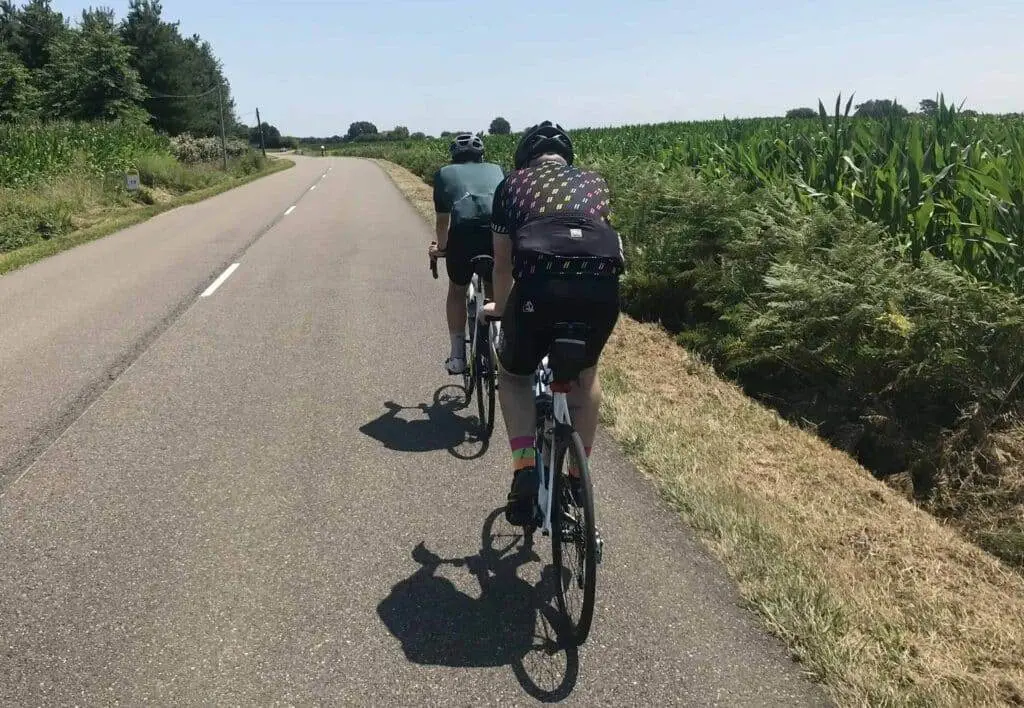
Increasing Your Cycling Speed (Closing Thoughts)
No matter your age, you don’t have to resign yourself to staying at the same speed or getting slower (unless you want to!). With good training, the right equipment and clothes, and good nutrition, you can continue working on your bike handling skills and fitness to maintain your speed or even get faster.
It’s time to put your skills to the test and show us how fast you can ride! Share your top speed and also your favorite rides in the comments below!
FAQ
Can Cyclists Get a Speeding Ticket?
Yes! Cyclists can and do get speeding tickets, especially in more congested, pedestrian-rich areas.
What is FTP? And what does it have to do with speed?
Your FTP is the amount of power you can produce by pedalling over one hour. The higher your FTP, the more power you can produce, and the faster you will go. While FTP doesn’t consider everything, it is a great metric for training.
How Can I Calculate my FTP?
You’ll need a power meter on your bike to find your FTP. Then, you’ll take an FTP test. Typically, you’ll ride as hard as you can for one hour. This will give you a number in the form of watts, which is your FTP.
What is considered a fast cycling speed?
Fast cycling speed varies depending on the context. In cycling, it can range from 10-15 mph for recreational cyclists to over 25 mph for professional road cyclists. In computing, it relates to a CPU’s clock speed, measured in gigahertz or terahertz.
Additionally, it can refer to electrical frequencies, athletic performance, or metabolic rates, with what’s considered ‘fast’ differing in each domain.
